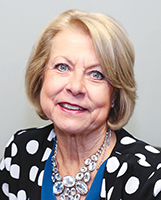
Inside AASA
MaryAnn Jobe on Leadership Development
School Administrator, March 2017
 |
MaryAnn Jobe
|
For more than 30 years, MaryAnn Jobe worked for Montgomery County Public Schools in Rockville, Md. in several capacities, including stints as an administrator in high schools and the central office.
Since 2008, Jobe has worked as director for leadership development in AASA’s Leadership Services and Awards Department. She oversees the association’s projects on education leadership for principals and women’s leadership, funded respectively by The Wallace Foundation and the Bill & Melinda Gates Foundation.
The following interview by AASA staff member Rebecca Shaw has been edited for length and clarity.
What are the leadership trends for K-12 education and for women in particular?
Twenty five years ago, 6.5 percent of superintendents were women; a 2016 AASA survey of state association executives found 22.4 percent of the superintendents are led by women, including several of the largest school districts in the country.
What’s the major difference between women’s and men’s career path when they ascend to leadership positions in school districts?
Typically, women ascend to top leadership positions later in their career; they often leave the classroom for positions in administration. My career has followed this pattern. I spent half my career in the classroom, because I loved teaching and coaching. Then I moved to leadership positions in schools and central office.
It’s not uncommon that males spend 3-5 years as a teacher and hit the superintendency before the age of 30, especially in rural school districts.
What’s AASA’s approach to women’s leadership development?
AASA has designed a mentorship program for women supported by the Gates Foundation. We have created a consortium of 10 women leaders from business, K-12 education and higher ed to mentor aspiring leaders. These mentors can help them understand how to navigate the leadership waters so they can go from teacher leader to principal, then to central office and ultimately, to the superintendency.
We involve all of these women in thought leader discussions and networking opportunities where they can learn from one another.
How is AASA uniquely positioned to serve those in education who aspire for the top school system leadership positions, for both men and women?
The principalship is a stepping stone to the superintendency. If principals are not well-grounded in research, curriculum and instruction and leadership going into the superintendency, it might be more difficult for them to be successful. AASA is able to bring a wealth of research and resources to leaders in the education community.
What progress have you seen in districts participating in the Wallace principal pipeline initiative?
Since 2010, AASA has increased awareness of the critical problem education faces because of attrition in the leadership ranks. Workshops at the National Conference on Education, social media communication and articles in
School Administrator focused on this problem and the need for better succession planning.
Over the past six years, six urban districts have worked on the principal pipeline initiative by partnering with local universities and providers to create principal pipelines.
In addition, the creation of leader-tracking systems has helped these school districts grow their own leaders by using data to inform decisions. Each leader-tracking system is developed by the school district by integrating the districts’ SIS and LMS systems.
What communication do you provide for the principal pipeline initiative?
We have partnered on webinars with Learning Forward on the Model Principal Supervisor Professional Standards 2015 to help those who supervise principals understand the national standards and their context. Our webinars attract 200-300 participants per session. We also disseminate research findings to the greater education community.
How do you hope AASA’s leadership development work for women and principals will evolve over the next few years?
Our women’s initiative and leadership work will help school districts look at candidates across the entire spectrum of education. In addition, AASA is the technical assistance provider for a new Wallace grant on the University Principal Preparation Initiative, which involves seven universities and 21 school districts. AASA will work closely with each district on developing a leader-tracking system to increase the pool of available leaders.
I think all of this is going hand in hand [with the idea that] leadership is leadership. We want opportunities available for everyone who is highly qualified— we’d love school districts to level the playing field.
*Inside AASA is a new monthly feature about AASA services and products and the staff members behind them. Read full versions of the interviews
here.*